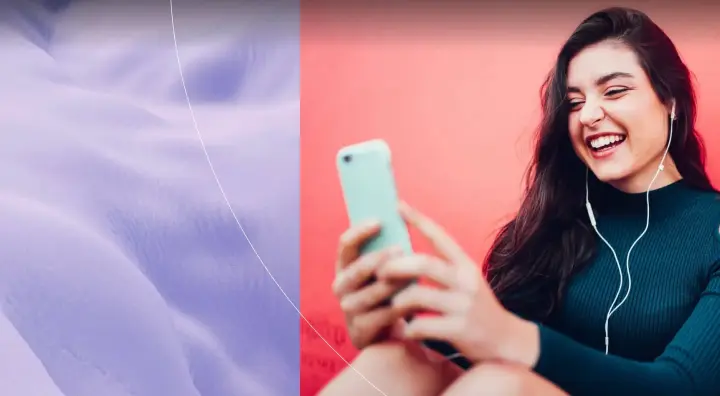You might have noticed something called VideoAsk popping up around our site lately. And if you haven't, let us introduce you.
What is VideoAsk? Is it part of Typeform, or a standalone product? Should I be excited about it? What would I even use it for? How is it different to Snapchat?
These were some of the questions flying around our office when we first launched VideoAsk. Now that we have some answers, we’ll pass them on to you. Maybe you’ll become what the industry calls an “early adopter,” which is like the tech version of being trendy.
Let’s start with that first question.
Latest posts on Product
What is VideoAsk?
VideoAsk is a web app—also works on Android, and there's an iPhone app too—that lets you ask your audience questions, and receive answers, face-to-face. Here’s how it works:
Record a video of yourself asking a question with the VideoAsk app
Share the link or embed it into any webpage
Receive answers from your audience in video, voice, or text format
Follow up with another video to start a conversation
That’s the basics covered. But hang on…
Can’t you already do this with Snapchat?
Well, sort of. But that’s a bit like asking “Can’t you already do everything Slack does with WhatsApp?” There’s a reason we use one for sending GIFs to friends, and the other for sending GIFs to coworkers.
VideoAsk is designed to help businesses form more personal connections with their audiences. Typeform Cofounder and Head of R&D, David Okuniev, explains:
“We want to shorten the journey to setting up a face-to-face meeting with someone—or even avoid it entirely. It’s not just about collecting answers. We’re trying to create relationships.”
As a result, it comes with a bunch of relationship-starting features:
Frictionless responding. Respondents click the link to your VideoAsk, record or write their answer, and send it. No need for them to ‘add’ you, ‘follow’ you, or even download the app.
Easily add a contact form. Automatically ask people for their name and email after they’ve recorded a response. So you can…
Continue the conversation. Reply directly to respondents via video, and manage all your ongoing conversations within the app.
And since VideoAsk helps businesses reach a wide audience in a personal way, it’s also designed to be scalable—like a traditional form:
Transcribe your responses. Turn your video and audio answers into text. English, German, French, Portuguese, Spanish, Italian, Russian—and more to come.
Multi-step VideoAsks. Set up a chain of questions in a single VideoAsk, so you’ll appear asking the next question right after your respondent has answered the previous.
Non-video answers. Let people respond by text to capture responses from video-shy people.
Want another perspective? Here’s coach and Founder of weand.me Chad’s take:
OK, that’s the elevator pitch out of the way. Time to get deep.
Why use VideoAsk?
Good question. Let’s start by putting it another way: why did we make VideoAsk?
Since the rise of instant messaging, most communication is now text-based. But 20 years ago, when you needed to reach someone you’d pick up the phone. You could sense what kind of mood they were in that day. Or if they were in a rush. Or if they weren’t really sure of what they were saying.
Text conceals this kind of information. So we want to bring more personal interactions back.
“You get so much more from a video response. Beyond the information, you get context, personality, and feeling. That’s something you can’t reproduce in text.”
We found this ourselves when we made a VideoAsk to get feedback from Typeform unsubscribers. People were pleasantly surprised to see the cofounder pop up asking why they left. It made them realize we actually care about what they have to say—in a way that doesn’t quite get captured through a traditional form.
And in return, the responses we got were fascinating. Our normal feedback Typeform is hooked up to a Slack channel for all to see—an endless reel of faceless comments about our product. Useful for sure, but after a while it all starts to blend into one big bowl of feedback soup.
But with the VideoAsk feedback, our users stopped feeling like users. Turns out, they were actually people the whole time. People just like us. Suddenly it was easy to empathise with their reasons for leaving Typeform. You don’t even have to try to understand—you just get it.
And that’s not the only place where face-to-face forms work.
What can I use VideoAsk for?
Other than sending videos saying “beers?” to their colleagues at 5pm on a Friday, so far people are using VideoAsk for four main things.
1. Job applications
A friend of mine lied on his resume, saying that he’d done an internship at Goldman & Sachs. He got an interview, and later got hired for his first ‘proper’ job. After several promotions, he still works there to this day.
How did he pass the interview even though his resume was full of white lies? Because he’s a great guy, and that made up for his inexperience. You can fake a resume, but you can’t fake a personality.
VideoAsk lets you get a vibe from your job applicants before you meet them. It also lets them get a vibe from your company—something that’s missing from most hiring processes.
2. Contact forms and lead generation
Website contact forms are as old as the internet itself. And to be honest, they’ve started to show their age. First you have to locate them in some hidden corner of a website and punch in your details. Then hope someone checks that inbox some time in the next two months.
This is followed by an email exchange, which is followed by some back-and-forth to arrange a call, and only then do you finally get to meet the face behind the form.
With VideoAsk, you are your contact form. People meet you as soon as they land on your site, which means they can connect with your personality from the off. Or, maybe they won’t—it’s a bold move to put yourself front and center of your homepage.
Here's a real example of a VideoAsk contact form done right. It's a copy, so Tara won't get your responses.
If you’re confident that your shining personality will attract the right people, VideoAsk is a game-changer. Read the full story behind the example above further down.
3. Testimonials
When learning about a new product, I often find myself scanning its website for customer quotes. “Let’s hear what a real person has to say about this,” I think to myself, avoiding all the carefully crafted marketing slogans.
Customer quotes are great because they explain products from your perspective as a customer. But they can also be “polished,” “tweaked,” or even “drafted” by writers on marketing teams. Source: I’m a writer on a marketing team.
On the other hand, a VideoAsk testimonial is simple to record, and oozes authenticity. You can see and hear what people really feel about a product in a direct, unfiltered way.
4. Feedback
As we learned at Typeform, getting face-to-face feedback is very different from looking at a graph of NPS scores. Both are useful in different ways—NPS to get the bigger picture, VideoAsk to really feel what your users are going through.
You can also follow up with the people who give the most interesting thoughts on your product and instantly start a conversation. For product designers, it’s a great opportunity to close the feedback loop.
Time for a curveball.
Don’t a lot of people find it awkward to film themselves?
Short answer: yes. And that’s a challenge. Both for VideoAskers, and for us.
“The biggest hurdle is getting people comfortable with using video. We need to develop tools to make people feel more comfortable. We thought about adding avatars and masks, but that kind of defeats the point.”
If the sight of yourself on a grainy phone screen makes you freeze up and lose all your charisma, you’re probably not the right ambassador for your company’s homepage. No worries—there’s always someone in the office who’re ready to give it a go.
On the respondent side, getting video answers can be hard sometimes too. Lots of respondents go for the text option. You can switch this off to encourage people to record their answers, but you might risk lowering your response count.
The solution? Pick the right context. If your primary objective is to collect tons of data, it’s probably best to stick to a more traditional form.
With VideoAsk, you gain a huge amount in quality. Better qualified leads. More detailed and vivid feedback. Relationships that start faster and stronger.
And here’s the proof.
Are people already getting good results?
Tara is a solo-preneur who runs The Biscuit Factory, a community for freelance creatives to get advice, attend online workshops, and help each other feel less alone.
A big part of her business is personally helping community members who are struggling. Tara is fun, approachable, and understanding—so it’s important for her website to embody her personality:
“People have come to a point in business where everything feels the same. So when you put authentic personality in front of whatever you’re selling, you’re going to stand out. People need that human connection.”
Potential community members used to connect with Tara by sending her an email or Facebook message. Then some back-and-forth would follow so she could get to know them better. But two months ago, Tara discovered VideoAsk:
“Before VideoAsk it was really awkward to communicate in a deeper way. I spent a lot of time saying “Let’s hop on a Zoom call.” Now I can instantly talk back to you, type back to you, or—if I’m feeling ballsy—send you a video.”
As well as using VideoAsk on the homepage of her site to attract leads, Tara also uses it to manage all her client conversations in one place. She can recommend content to people, coach people face-to-face, and ask for course feedback.
More than anything, it saves her time by letting her focus on the people who matter.
“You know that people who respond to your VideoAsk are really engaged with you. They’re your hot leads because they’ve made that step. It’s like a filter for your audience.”
As a result, Tara’s conversion rate has jumped to 41% since she started using VideoAsk. Not bad for a tool that’s still in its early days.
And it's being updated constantly, so there’s much more coming soon.
So is VideoAsk part of Typeform, or a separate thing, or what?
Right now we’re treating VideoAsk as a separate product, with its own website and brand. That means you need to sign up for free—but if you already have a Typeform account, you can just click a button to log in with these details.
Head over to videoask.com to give it a spin, or check out the pricing page here.







